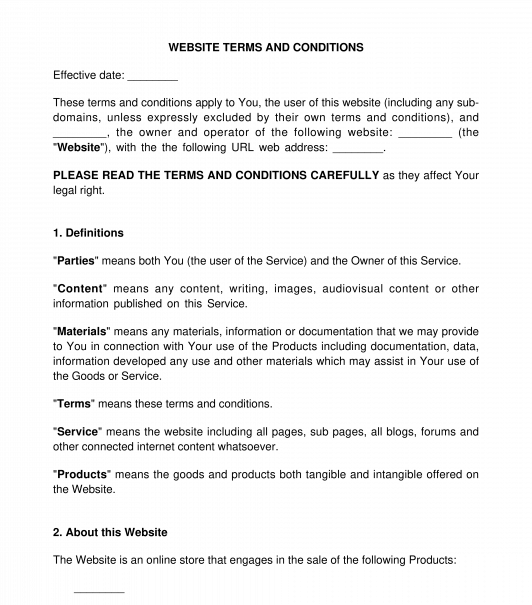 10/09/2025
10/09/2025

Answer a few questions and your document is created automatically.

Your document is ready! You will receive it in Word and PDF formats. You will be able to modify it.

 10/09/2025
10/09/2025
 Word and PDF
Word and PDF
 6 to 9 pages
6 to 9 pages



The Terms and Conditions of a Website/Application is an agreement that includes all the set rules and acceptable guidelines relating to the use of a website or application. This is used for website, application, or online store.
This document serves as an agreement between the owner of the website or application and its users. The owner is the person or company that owns a website or application and the users are people who use the websites or application. This document enables the owner to set rules relating to the use of its website/application. These rules include, but not limited to the following:
Every online store, website, or mobile application requires this document to create a contractual relationship between the owner of the online store or website and their users. Other important documents for website or application include the Privacy Policy, Cookie Policy, and Refund Policy.
How to use this document
This document can be used by any individual or company that owns a website/application as it creates a binding agreement between the owner and the users. After filling out this document, it should be published on the website or application.
Some websites or applications simply make the terms and conditions available on a separate page, usually accessible via a hyperlink that appears on the same page. In this case, the end user may not review the terms before accepting the contract. This is called the browse wrap agreement. Other websites or application make the users take positive steps to confirm that the user has read the terms and conditions. For example, the site or application may have a pop up box showing the terms and conditions where the user will be required to scroll all the way through the terms and conditions before checking the box saying "I understand the terms and conditions of this website and have agreed to be bound by them". This is called a click wrap agreement.
Applicable laws
Although there is no standard law that stipulates the provision of this agreement, the National Information Technology Development Agency (NITDA) Guidelines set rules for the protection of personal data and privacy policy.
Also, there are general laws that regulate Information Technology and Communications, such as the Copyright Act, which ensures the protection of intellectual property, and the National Information Technology Development Act.
On May 25, 2018, the European Union (EU) General Data Protection Regulation (GDPR) came into effect to ensure the protection of personal data. It addresses the export of personal data outside the European Union. This regulation is applicable to Nigerian businesses if they offer products and services in the EU or if they process the personal data of people in the EU.
How to modify the template
You fill out a form. The document is created before your eyes as you respond to the questions.
At the end, you receive it in Word and PDF formats. You can modify it and reuse it.
Country: Nigeria